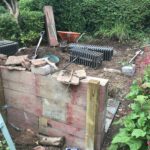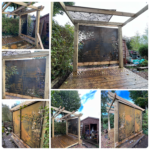Above is the screen garden as of Summer 2024. It’s still evolving and I’ll keep you abreast of developments. Below, you will be able to track the journey to this point. From humble beginnings and the seeds of an idea … until now. The pictures above will change as the garden progresses still further.
The beginning , April 2021.
As with many of my garden projects, the ideas were somewhat loose at the beginning and slowly emerged as the space spoke to me. In this case, the screen garden as it is now (see pics at the top), was not in my head at the beginning. The primary objective was to create a space that complemented the lower shed. I wanted it to be an entertaining space, a space for socialising, barbeques, and general relaxation. I could picture a group of us in the shed enjoying convivial banter while the waft of bbq smoke merged with the aromas of wine, whisky and beer. A confession … a lot of the garden has been designed with the idea of other people enjoying it alongside ourselves … but we rarely entertain. It’s not that we’re unsociable, it’s simply not on our habitual radar. However, the bones of the plan were there, the flesh could wait.
Clearing space for planting or building has never been an easy task in this garden. When the house was built in 1929 I’m almost certain that no consideration was given to the garden. It was built on what was Lady Cave’s estate, the remnants of an orchard still existed at the bottom of the sloping stretch. Any hardcore that resulted from the build seems to have been loosely covered … and left for nature to cover with the detritus of the seasons. The result is that, after removing the top 12 inches of soil you are confronted with rust coloured soil and stones … lots of stones!
Due to the gentle slope of the land, one of the standard considerations in any design is terracing. This brings me to my love of reclamation yards! Visiting a good quality rec yard can be an inspirational experience and we are fortunate to have two or three within easy reach. With the aim of finding something to “hold” the terrace, a visit ensued. There was more than one exciting purchase which you might have noticed in the pics above but in terms of the primary objective, I found what I wanted within 5 minutes. From a pile of probably over a hundred, I bought 20 short, stout, wooden sleepers. The stocky dimensions were impressive – 5ft long, 12 inches wide and 8 inches deep. Yes! I know that wood will rot down over time (don’t we all), but these muscly blocks will undoubtedly outlast me.
The second purchase was very exciting! Walking slowly around the seemingly uncoordinated rows, piles, stacks, and accumulations of stone, metal, and wood garnered from near and far over many decades, I saw them … the radiators. Matt black, squat and imposing, three of them, in varying lengths. I was drawn to them immediately, my first thought being “seating”. I could imagine them, in the screen garden, topped with reclaimed oak beams/sleepers, adorned by the bums of friends gathered around a fire pit/bbq exchanging drunken nonsense. Not cheap … not cheap at all, but they would outlast me (I sense a theme developing here – gardening and longevity).
The radiators seemed in good nick, minimal rust and unbelievably heavy … they were monsters! Purchase and delivery confirmed, I spent 10 mins talking to Ben (owner of the yard). He told Jenny and I that the radiators came from a local house (Little Sodbury Manor) that was being refurbished/repurposed. To have provenance in relation these cast-iron Goliath’s was exciting enough … further research on the manor house escalated things. The manor dates back to the C15th, Henry VIII & Anne Boleyn stayed there and William Tyndale worked there! Now, whilst these rads won’t have warmed Henry & Anne’s Tudor cockles, or the hands of William Tyndale as he struggled in translating the bible into English (the rads were probably installed sometime in the C19th) who knows what succour they have offered (and to whom?) over the last 200 years or so? On some levels it’s sad that these beasts were taken from their home, however, no roughly handled drag to the “smelt” for them, and they now continue their service as part of the screen garden. Something we’re grateful for.
The retaining wall and seating addressed for now, my thoughts turned to screening. I wanted an enclosed but not shut-off feel to this space. There needed to be a connection to the lower shed to the left and the attached decking that housed my seasonal collection of pots/flowers. I didn’t want a screen that would be colonised by foliage, I could build that into the wooden panel on the right which would screen out the possibility of being overlooked. I wanted something that would provide a glimpse beyond, something with an organic feel, something that was a feature in and of itself. After many online hours researching what was out there, I settled on the screens you can see in the pics. They have a willow design that allows glimpses through to a vegetable patch. The veg patch itself isn’t traditionally “pretty” but the screens mask the ordinary and hint at something altogether more aesthetically pleasing. It also draws the eye up and over the veg patch and chicken coop to the greenhouse, magnolia, paulownia tomentosa, and the allotments beyond (see pic 4 below).
By this time I had been seduced by the charms of Corten steel.
Why do I like/love it? I knew nothing about its back story. I knew that I liked the colour and the fact that it was steel! I’d seen the wide variety of sculpted pieces on-line (and occasionally in situ in various gardens, both public and private). It was no surprise then, that in working and re-working sections of the garden, the phrase “Corten steel” was never far from my mind.
The back story: In putting this section together I decided to do a little research into the product, and in looking closer at the history of Corten steel I came across a number of facts that were new to me and that you may find interesting.
- It was first developed in the 1930’s by the US Steel corporation.
- COR stands for corrosion resistance and TEN stands for tensile strength.
- It wasn’t used in an architectural sense until the 1950’s
- The outer appearance is a protective rust layer called a “patina” that inhibits further corrosion and extends the life and use of the steel.
- While weathering steel can rust, it only does so on the outer surface. If the outer coating of rust has grown, the rust does not go further into the steel. The rust-coated surface serves as a kind of protective shield, preventing the steel from any additional corrosion.
NB Above facts were drawn from simple on-line search
The aesthetics: Having discovered these facts, I have become both comfortable and committed to the product. Despite the positive qualities of Corten steel in terms of its durability (& to some extent, its carbon footprint), it was the aesthetic qualities that, for me, were the primary drivers. I’m drawn to the rust colour and its “earthy” quality, hinting at the passing of time, acting as a bridge between the organic nature of the garden landscape, and the wrought workings of both science and industry. Its interaction with light is also an aesthetically pleasing strength. The light playing on, over, and through the steel provides an ever changing dynamic, resulting in a product that beds in almost immediately it is installed, sitting comfortably within the garden environment.
As you can see from the photos, in the winter months, when frost toys with the garden, the well-defined edges offer both crisp lines and a soft feel. The “soft” feel will, of course, depend on your choice of template. My preference in terms of the feel of the screen garden is for a willow/palm effect.
I mentioned reclamation yards earlier, it was now time to pay another visit just to see what was around …
more to come
More to come






































